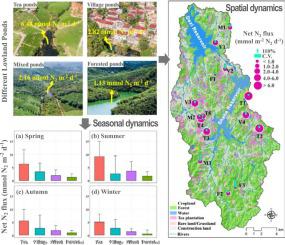Agriculture, Ecosystems & Environment ( IF 6.0 ) Pub Date : 2022-08-10 , DOI: 10.1016/j.agee.2022.108121 Wangshou Zhang , Hengpeng Li , Tianyu Xia , Heng Cao

|
The lowland ponds, depressional submerged areas that are fed by runoff from surrounding uplands and then send overflows to downstream water bodies, are recognized as biogeochemical hotspots of nitrogen (N) removal. Despite their important role in mitigating N pollution, very little is currently known about their potential for N removal, particularly for those ponds draining contrasting land uses. Our study investigated the variabilities of N removal in different types of ponds from a hilly watershed by quantifying gaseous N2 emission fluxes. The mean excess N2 concentrations relative to its saturations varied within 0.41–16.44 μmol L−1, demonstrating that significant N removal occurred in all of the ponds. Further estimates of net N2 fluxes suggested that ponds impacted by different land use types exhibited distinct potentials for N removal. The ponds that drained tea plantations, which are a typical form of agriculture in hilly regions, had the highest N removal rate (6.48 mmol N2 m−2 d−1), equivalent to ~2.3, 3.0, and 5.8 times those drained by residential areas, mixed-landscape, and forests, respectively. The levels of dissolved oxygen and nutrient supply affected by the different drained land uses were responsible for the different potentials of N removal. Our results suggest that there is a need for integrated management strategies that not only focus on optimization of environmental conditions in ponds but also consider the impacts of the land use compositions in their drainages to more efficiently promote N removal.
中文翻译:

来自不同低地池塘的净 N2 通量排出丘陵集水区不同的土地利用:对氮去除及其环境控制的影响
低地池塘,低洼淹没区,由周围高地的径流补给,然后将溢流送到下游水体,被认为是氮 (N) 去除的生物地球化学热点。尽管它们在减轻氮污染方面发挥着重要作用,但目前对其去除氮的潜力知之甚少,特别是对于那些排水不同土地用途的池塘。我们的研究通过量化气态 N 2排放通量,调查了丘陵流域不同类型池塘中 N 去除的变化。相对于其饱和度的平均过量 N 2浓度在 0.41-16.44 μmol L -1范围内变化,这表明在所有池塘中都发生了显着的 N 去除。净 N 2的进一步估计通量表明,受不同土地利用类型影响的池塘表现出不同的氮去除潜力。排干茶园的池塘是丘陵地区典型的农业形式,其氮去除率最高(6.48 mmol N 2 m -2 d -1),分别相当于住宅区、混合景观和森林排水量的约 2.3、3.0 和 5.8 倍。受不同排水土地利用影响的溶解氧和养分供应水平是造成氮去除潜力不同的原因。我们的研究结果表明,需要综合管理策略,不仅要关注池塘环境条件的优化,还要考虑排水系统中土地利用成分的影响,以更有效地促进 N 去除。











































 京公网安备 11010802027423号
京公网安备 11010802027423号